Jōban Line
| Joban Line | |||
|---|---|---|---|
| JJJL | |||
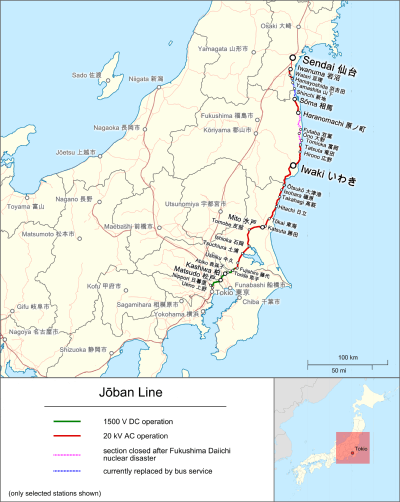 | |||
| Overview | |||
| Native name | 常磐線 | ||
| Type | Heavy rail | ||
| Locale | Tokyo, Chiba, Ibaraki, Fukushima, Miyagi prefectures | ||
| Termini |
Nippori Iwanuma | ||
| Stations | 85 | ||
| Operation | |||
| Opened | 16 January 1889 | ||
| Completed | 1 April 1905 | ||
| Owner | JR East | ||
| Operator(s) | JR East, JR Freight | ||
| Technical | |||
| Track length | 368.0 km (228.7 mi) | ||
| Track gauge | 1,067 mm (3 ft 6 in) | ||
| Electrification | 1,500 V DC & 20 kV AC 50 Hz overhead catenary | ||
| |||
| Joban Line | |||||||||||||||||||||||||||||||||||||||||||||||||||||||||||||||||||||||||||||||||||||||||||||||||||||||||||||||||||||||||||||||||||||||||||||||||||||||||||||||||||||||||||||||||||||||||||||||||||||||||||||||||||||||||||||||||||||||||||||||||||||||||||||||||||||||||||||||||||||||||||||||||||||||||||||||||||||||||||||||||||||||||||||||||||||||||||||||||||||||||||||||||||||||||||||||||||||||||||||||||||||||||||||||||||||||||||||||||||||||||||||||||||||||||||||||||||||||||||||||||||||||||||||||||||||||||||||||||||||||||||||||||||||||||||||||||||||||||||||||||||||||||||||||||||||||||||||||||||||||||||||||||||||||||||||||||||||||||||||||||||||||||||||||||||||||||||||||||||||||||||||||||||||||||||||||||||||||||||||||||||||||||||||||||||||||||||||||||||||||||||||||||||||||||||||||||||||||||||||||||||||||||||||||||||||||||||||||||||||||||||||||||||||||||||||||||||||||||||||||||||||||||||||||||||||||||||||||||||||||||||||||||||||||||||||||||||||||||||||||||||||||||||||||||||||||||||||||||||||||
|---|---|---|---|---|---|---|---|---|---|---|---|---|---|---|---|---|---|---|---|---|---|---|---|---|---|---|---|---|---|---|---|---|---|---|---|---|---|---|---|---|---|---|---|---|---|---|---|---|---|---|---|---|---|---|---|---|---|---|---|---|---|---|---|---|---|---|---|---|---|---|---|---|---|---|---|---|---|---|---|---|---|---|---|---|---|---|---|---|---|---|---|---|---|---|---|---|---|---|---|---|---|---|---|---|---|---|---|---|---|---|---|---|---|---|---|---|---|---|---|---|---|---|---|---|---|---|---|---|---|---|---|---|---|---|---|---|---|---|---|---|---|---|---|---|---|---|---|---|---|---|---|---|---|---|---|---|---|---|---|---|---|---|---|---|---|---|---|---|---|---|---|---|---|---|---|---|---|---|---|---|---|---|---|---|---|---|---|---|---|---|---|---|---|---|---|---|---|---|---|---|---|---|---|---|---|---|---|---|---|---|---|---|---|---|---|---|---|---|---|---|---|---|---|---|---|---|---|---|---|---|---|---|---|---|---|---|---|---|---|---|---|---|---|---|---|---|---|---|---|---|---|---|---|---|---|---|---|---|---|---|---|---|---|---|---|---|---|---|---|---|---|---|---|---|---|---|---|---|---|---|---|---|---|---|---|---|---|---|---|---|---|---|---|---|---|---|---|---|---|---|---|---|---|---|---|---|---|---|---|---|---|---|---|---|---|---|---|---|---|---|---|---|---|---|---|---|---|---|---|---|---|---|---|---|---|---|---|---|---|---|---|---|---|---|---|---|---|---|---|---|---|---|---|---|---|---|---|---|---|---|---|---|---|---|---|---|---|---|---|---|---|---|---|---|---|---|---|---|---|---|---|---|---|---|---|---|---|---|---|---|---|---|---|---|---|---|---|---|---|---|---|---|---|---|---|---|---|---|---|---|---|---|---|---|---|---|---|---|---|---|---|---|---|---|---|---|---|---|---|---|---|---|---|---|---|---|---|---|---|---|---|---|---|---|---|---|---|---|---|---|---|---|---|---|---|---|---|---|---|---|---|---|---|---|---|---|---|---|---|---|---|---|---|---|---|---|---|---|---|---|---|---|---|---|---|---|---|---|---|---|---|---|---|---|---|---|---|---|---|---|---|---|---|---|---|---|---|---|---|---|---|---|---|---|---|---|---|---|---|---|---|---|---|---|---|---|---|---|---|---|---|---|---|---|---|---|---|---|---|---|---|---|---|---|---|---|---|---|---|---|---|---|---|---|---|---|---|---|---|---|---|---|---|---|---|---|---|---|---|---|---|---|---|---|---|---|---|---|---|---|---|---|---|---|---|---|---|---|---|---|---|---|---|---|---|---|---|---|---|---|---|---|---|---|---|---|---|---|---|---|---|---|---|---|---|---|---|---|---|---|---|---|---|---|---|---|---|---|---|---|---|---|---|---|---|---|---|---|---|---|---|---|---|---|---|---|---|---|---|---|---|---|---|---|---|---|---|---|---|---|---|---|---|---|---|---|---|---|---|---|---|---|---|---|---|---|---|---|---|---|---|---|---|---|---|---|---|---|---|---|---|---|---|---|---|---|---|---|---|---|---|---|---|---|---|---|---|---|---|---|---|---|---|---|---|---|---|---|---|---|---|---|---|---|---|---|---|---|---|---|---|---|---|---|---|---|---|---|---|---|---|---|---|---|---|---|---|---|---|---|---|---|---|---|---|---|---|---|---|---|---|---|---|---|---|---|---|---|---|---|---|---|---|---|---|---|---|---|---|---|---|---|---|---|---|---|---|---|---|---|---|---|---|---|---|---|---|---|---|---|---|---|---|---|---|---|---|---|---|---|---|---|---|---|---|---|---|---|---|---|---|---|---|---|---|---|---|---|---|---|---|---|---|---|---|---|---|---|---|---|---|---|---|---|---|---|---|---|---|---|---|---|---|---|---|---|---|---|---|---|---|---|---|---|---|---|---|---|---|---|---|---|---|---|---|---|---|---|---|---|---|---|---|---|---|---|---|---|---|---|---|---|---|---|---|---|---|---|---|---|---|---|---|---|---|---|---|---|---|---|---|---|---|---|---|---|---|---|---|---|---|---|---|---|---|---|---|---|---|---|---|---|---|---|---|---|---|---|---|---|---|---|---|---|---|---|---|---|---|---|---|---|---|---|---|---|---|---|---|---|---|---|---|---|---|---|---|---|---|---|---|---|---|---|---|---|---|---|---|---|---|---|---|---|---|---|---|---|---|---|---|---|---|---|---|---|---|---|---|
| |||||||||||||||||||||||||||||||||||||||||||||||||||||||||||||||||||||||||||||||||||||||||||||||||||||||||||||||||||||||||||||||||||||||||||||||||||||||||||||||||||||||||||||||||||||||||||||||||||||||||||||||||||||||||||||||||||||||||||||||||||||||||||||||||||||||||||||||||||||||||||||||||||||||||||||||||||||||||||||||||||||||||||||||||||||||||||||||||||||||||||||||||||||||||||||||||||||||||||||||||||||||||||||||||||||||||||||||||||||||||||||||||||||||||||||||||||||||||||||||||||||||||||||||||||||||||||||||||||||||||||||||||||||||||||||||||||||||||||||||||||||||||||||||||||||||||||||||||||||||||||||||||||||||||||||||||||||||||||||||||||||||||||||||||||||||||||||||||||||||||||||||||||||||||||||||||||||||||||||||||||||||||||||||||||||||||||||||||||||||||||||||||||||||||||||||||||||||||||||||||||||||||||||||||||||||||||||||||||||||||||||||||||||||||||||||||||||||||||||||||||||||||||||||||||||||||||||||||||||||||||||||||||||||||||||||||||||||||||||||||||||||||||||||||||||||||||||||||||||||

The Jōban Line (常磐線 Jōban-sen) is a railway line in Japan operated by East Japan Railway Company (JR East). It begins at Nippori Station in Arakawa, Tokyo and approximately parallels the Pacific coasts of Chiba, Ibaraki, and Fukushima Prefectures before the line officially ends at Iwanuma Station in Iwanuma, Miyagi. However, northbound trains at Tokyo originate at Ueno (and Shinagawa with the opening of the Ueno-Tokyo Line on March 14, 2015) rather than Nippori; likewise, many trains continue past Iwanuma onto the Tōhoku Main Line tracks to Sendai.
The name "Jōban" is derived from the names of the former provinces of Hitachi (常陸) and Iwaki (磐城), which are connected by the line to reach Tokyo.
The section of the Joban Line between Tomioka and Namie, which extends through the exclusion zone surrounding the Fukushima Daiichi nuclear meltdown, remains closed in the wake of the 2011 Tōhoku earthquake and tsunami and Fukushima Daiichi nuclear disaster, and is expected to reopen in March 2020.[1]
Basic data
- Operators, distances:
- East Japan Railway Company (JR East) (Services and tracks)
- Nippori – Haranomachi – Iwanuma: 343.1 km (213.2 mi)
- Mikawashima – Sumidagawa – Minami-Senju (Sumidagawa freight branch): 5.7 km (3.5 mi)
- Mikawashima – Tabata (Tabata freight branch): 1.6 km (1.0 mi)
- Japan Freight Railway Company (JR Freight) (Services)
- Mikawashima – Haranomachi – Iwanuma: 341.9 km (212.4 mi)
- Mikawashima – Sumidagawa – Minami-Senju (Sumidagawa freight branch): 5.7 km (3.5 mi)
- Mikawashima – Tabata (Tabata freight branch): 1.6 km (1.0 mi)
- East Japan Railway Company (JR East) (Services and tracks)
- Double/quadruple tracking:
- Quadruple: Ayase – Toride
- Double: Nippori – Ayase, Toride – Yotsukura, Hirono – Kido, Ōno – Futaba
- Electrification:
- 1,500 V DC: Nippori – Toride, Mikawashima – Sumidagawa – Minami-Senju, Mikawashima – Tabata
- 20 kV AC, 50 Hz: Fujishiro – Iwanuma. This section of the line, along with a nearby section of the Tsukuba Express in Ibaraki Prefecture (Moriya – Tsukuba), uses alternating current in order to minimize interference with the nearby Kakioka Magnetic Observatory in Ishioka.[2]
- The dead section is located between Toride and Fujishiro
- Railway signalling:
- Automatic Train Control (ATC): Ayase – Toride
- Automatic Signaling Block for all other sections
- operation control
Services
The Jōban Line connects Tokyo and the Tōhoku region. After the opening of the Tōhoku Shinkansen in 1982, the Jōban Line was split into two parts at Iwaki. South of Iwaki is mainly double track (Ayase - Toride is quad track), and north of Iwaki is predominantly single track. After the Fukushima disaster in 2011, the Jōban Line is further segmented in the Iwaki – Sendai section.
Shinagawa – Ueno – Iwaki
This entire section is served by a variety of services, which will be explained below by the sections where they operate in.
Limited express trains operate across the entire section. See Hitachi and Tokiwa for details.
Shinagawa – Ueno – Toride
This section is mainly served by local, rapid, medium distance train services serving the Greater Tokyo area.
- JL Local (各駅停車, literally means: Stops at every station): These local trains are commonly referred to as the Jōban Line (Local) 常磐線各駅停車. All local trains operate through services to the Tokyo Metro Chiyoda Line to/from Yoyogi-Uehara via Ayase, where the Jōban Line and Chiyoda Line meet; some trains continue through on the Odakyu Odawara Line to/from Hon-Atsugi or the Odakyu Tama Line to/from Karakida. Trains usually originate/terminate at Abiko. At rush hours, trains originate/terminate at Toride. Occasionally trains won't go too far, originating/terminating at Matsudo or Kashiwa.
- JJ Rapid (快速): Rapid trains are commonly referred to as the Jōban Line (Rapid) 常磐線快速. These services run between the southern termini of Ueno or Shinagawa (via Ueno-Tokyo Line) to the northern termini of Toride. Some trains go on to the Narita Line to Narita via Abiko, and are referred to as Jōban・Narita Line (常磐・成田線) trains. Rapid trains will skip some stations between Kita-Senju and Abiko, that local services mentioned above would stop.
- Local (Medium distance) (普通, literally means: Regular) : The "local" here refers to medium distance trains that operate north beyond Toride and stop at all stations north of Toride. South of Toride, they operate as rapid services, and are referred as such.
- Special Rapid (特別快速) : Special Rapid trains operate between Shinagawa and Tsuchiura, during non-rush hours at hourly intervals. These trains skip stations that even rapid trains would stop. This service is created to compete with the neighbouring railway line, the Tsukuba Express.
Shinagawa – Ueno – Mito – Katsuta
Trains that run beyond Toride are distinctly referred to as the Jōban Line 常磐線, without the term "Rapid". Trains that are called Jōban Line (Rapid) cannot go beyond Toride, as their rolling stock cannot be powered by alternating current, which is the type of electrification that the section uses.
This section is mainly served by local trains.
- Local (普通) : These trains stop at every station north of Toride. Hence the name "local". There are two types of local trains:
- Medium distance : These medium distance trains, as mentioned above, operate from central Tokyo to north of Toride and stop at all stations there. They terminate at various stations, namely Tsuchiura, Mito and Katsuta.
- Special Rapid (特別快速) : Special Rapid trains stop at every station between Toride and Tsuchiura, so they're essentially the same as the medium distance trains, but become a different service once past south of Toride.
- Mito Line through service : These trains run through services to the Mito Line via Tomobe Station, operating from Oyama to Katsuta.
- Medium distance : These medium distance trains, as mentioned above, operate from central Tokyo to north of Toride and stop at all stations there. They terminate at various stations, namely Tsuchiura, Mito and Katsuta.
Mito – Iwaki
This section is mainly served by local trains.
- Local (普通) : These trains stop at every station, operating between Mito and Takahagi / Iwaki
- Medium distance / through service: In early morning and late night, few medium distance trains and Mito Line through trains operate to as far as Takahagi, which is located about mid-way in this section.
Iwaki – Sendai
Before the Fukushima Daiichi nuclear disaster and the 2011 Tōhoku earthquake and tsunami, local trains and limited express trains used to run across the entire section. However, due to the damages caused after the disaster, the section between Tomioka to Harunomachi had to be closed down, and services were suspended. The section had to be heavily segmented. Now, services are gradually returning to normal, as explained below.
Iwaki – Tomioka
The section is served by local service trains. Trains cannot continue on beyond Tomioka as they once did, because the section beyond is closed (explained below).
Tomioka – Namie
Currently, the section between Tomioka and Namie, which extends through the exclusion zone surrounding the Fukushima Daiichi nuclear meltdown, remains closed, and is expected to reopen in March 2020.[1] All train services are suspended, which are now temporarily replaced by buses operating between Tomioka and Namie / Haranomachi.
Namie – Sendai
This section is served by local service trains, which serves the Greater Sendai area.
The section was once partially closed due to the 2011 disaster, but has reopened in stages. The reconstructed segment between Hamayoshida and Sōma was reopened on 10 December 2016, prior to which services had been provided by an interim bus service.[3][4][5] JR East is currently inspecting the segment between Namie and Odaka in preparation for the surrounding areas being cleared for re-settlement.[6] Train services between Namie and Odaka resumed on 1 April 2017.[7] Train services between Tatsuta and Tomioka resumed on 21 October 2017.[8]
Station list

- The above is a diagram indicating Jōban Line service patterns within Greater Tokyo.
- For information on limited express services (i.e. Hitachi and Tokiwa), see their respective pages.
Shinagawa – Ueno – Mito – Iwaki
- Legend
- Trains stop at stations marked "●" and pass those marked "|"
| Official line name | Station | Japanese | Distance (km) | Local | Rapid
快速 |
Special Rapid
特別快速 |
Transfers | Tracks | Location | Prefecture | ||
|---|---|---|---|---|---|---|---|---|---|---|---|---|
| Between stations |
Total (from Nippori) | Kankō
各駅停車 |
Futsuu
普通(medium | |||||||||
| Tōkaidō Main Line | Shinagawa SGWJT03 |
品川 | – | 12.6 | to/from Tokyo Metro Chiyoda Line, Odakyu Odawara Line and Odakyu Tama Line [* 1] | ● | ● | ● |
|
Two | Minato | Tokyo |
| Shimbashi SMBJT02 |
新橋 | 4.9 | 7.7 | ● | ● | ● |
| |||||
| Tokyo TYOJT01JU01 |
東京 | 1.9 | 5.8 | ● | ● | ● |
|
Chiyoda | ||||
| Tōhoku Main Line | ||||||||||||
| Ueno UENJU02JJ01 |
上野 | 3.6 | 2.2 | ● | ● | ● |
|
Taitō | ||||
| Nippori NPRJJ02 |
日暮里 | 2.2 | 0.0 | ● | ● | ● |
|
Arakawa | ||||
| Jōban Line | ||||||||||||
| Mikawashima JJ03 |
三河島 | 1.2 | 1.2 | ● | ● | | | ||||||
| Minami-Senju JJ04 |
南千住 | 2.2 | 3.4 | ● | ● | | | Tsukuba Express (04) | |||||
| Kita-Senju JJ05 |
北千住 | 1.8 | 5.2 | ●[* 2] | ● | ● | ● |
|
Adachi | |||
| Ayase JL19 |
綾瀬 | 2.5 | 7.7 | ● | | | | | | | Four | ||||
| Kameari JL20 |
亀有 | 2.2 | 9.9 | ● | | | | | | | Katsushika | ||||
| Kanamachi JL21 |
金町 | 1.9 | 11.8 | ● | | | | | | | Keisei Kanamachi Line | ||||
| Matsudo JJ06 JL22 |
松戸 | 3.9 | 15.7 | ● | ● | ● | ● | Shin-Keisei Line | Matsudo | Chiba | ||
| Kita-Matsudo JL23 |
北松戸 | 2.1 | 17.8 | ● | | | | | | | |||||
| Mabashi JL24 |
馬橋 | 1.3 | 19.1 | ● | | | | | | | Nagareyama Line | ||||
| Shim-Matsudo JL25 |
新松戸 | 1.6 | 20.7 | ● | | | | | | | JM Musashino Line Nagareyama Line (Kōya) | ||||
| Kita-Kogane JL26 |
北小金 | 1.3 | 22.0 | ● | | | | | | | |||||
| Minami-Kashiwa JL27 |
南柏 | 2.5 | 24.5 | ● | | | | | | | Kashiwa | ||||
| Kashiwa JJ07 JL28 |
柏 | 2.4 | 26.9 | ● | ● | ● | ● | Tobu Urban Park Line | ||||
| Kita-Kashiwa JL29 |
北柏 | 2.3 | 29.2 | ● | | | | | | | |||||
| Abiko JJ08 JL30 |
我孫子 | 2.2 | 31.3 | ● | ● | ●[* 3] | | | Narita Line (Abiko Branch Line), some through services for Narita | Abiko | |||
| Tennōdai JJ09 JL31 |
天王台 | 2.7 | 34.0 | ○[* 4] | ● | ● | | | |||||
| Toride JJ10 JL32 |
取手 | 3.4 | 37.4 | ○[* 4] | ● | ● | ● | Jōsō Line | Toride | Ibaraki | ||
| End of suburban section | ||||||||||||
| Fujishiro | 藤代 | 6.0 | 43.4 | ● | ● | Two | ||||||
| Sanuki | 佐貫 | 2.1 | 45.5 | ● | ● | Ryūgasaki Line | Ryūgasaki | |||||
| Ushiku | 牛久 | 5.1 | 50.6 | ● | ● | Ushiku | ||||||
| Hitachino-Ushiku | ひたち野うしく | 3.9 | 54.5 | ● | ● | |||||||
| Arakawaoki | 荒川沖 | 2.7 | 57.2 | ● | ● | Tsuchiura | ||||||
| Tsuchiura | 土浦 | 6.6 | 63.8 | ● | ● | |||||||
| Kandatsu | 神立 | 6.1 | 69.9 | ● | ||||||||
| Takahama | 高浜 | 6.5 | 76.4 | ● | Ishioka | |||||||
| Ishioka | 石岡 | 3.6 | 80.0 | ● | ||||||||
| Hatori | 羽鳥 | 6.5 | 86.5 | ● | Omitama | |||||||
| Iwama | 岩間 | 5.4 | 91.9 | ● | Kasama | |||||||
| Tomobe | 友部 | 6.9 | 98.8 | ● | Mito Line (some trains through to Mito) | |||||||
| Uchihara | 内原 | 4.7 | 103.5 | ● | Mito | |||||||
| Akatsuka | 赤塚 | 5.8 | 109.3 | ● | ||||||||
| Kairakuen | 偕楽園 | 4.1 | 113.4 | ●[* 5] | ||||||||
| Mito | 水戸 | 1.9 | 115.3 | ● | Suigun Line Kashima Rinkai Railway Ōarai Kashima Line | |||||||
| Katsuta | 勝田 | 5.8 | 121.1 | ● | Minato Line | Hitachinaka | ||||||
| Sawa | 佐和 | 4.2 | 125.3 | ● | ||||||||
| Tōkai | 東海 | 4.7 | 130.0 | ● | Tōkai, Naka District | |||||||
| Ōmika | 大甕 | 7.4 | 137.4 | ● | Hitachi | |||||||
| Hitachi-Taga | 常陸多賀 | 4.6 | 142.0 | ● | ||||||||
| Hitachi | 日立 | 4.9 | 146.9 | ● | ||||||||
| Ogitsu | 小木津 | 5.5 | 152.4 | ● | ||||||||
| Jūō | 十王 | 4.2 | 156.6 | ● | ||||||||
| Takahagi | 高萩 | 5.9 | 162.5 | ● | Takahagi | |||||||
| Minami-Nakagō | 南中郷 | 4.5 | 167.0 | ● | Kitaibaraki | |||||||
| Isohara | 磯原 | 4.6 | 171.6 | ● | ||||||||
| Ōtsukō | 大津港 | 7.1 | 178.7 | ● | ||||||||
| Nakoso | 勿来 | 4.5 | 183.2 | ● | Iwaki | Fukushima | ||||||
| Ueda | 植田 | 4.6 | 187.8 | ● | ||||||||
| Izumi | 泉 | 7.2 | 195.0 | ● | ||||||||
| Yumoto | 湯本 | 6.5 | 201.5 | ● | ||||||||
| Uchigō | 内郷 | 3.5 | 205.0 | ● | ||||||||
| Iwaki | いわき | 4.4 | 209.4 | ● | Banetsu East Line | |||||||
- ↑ All trains through to/from Yoyogi-Uehara; some trains continue through on the Odakyu Odawara Line to/from Hon-Atsugi and the Odakyu Tama Line to/from Karakida
- ↑ Local trains to/from the Tokyo Metro Chiyoda Line use the underground Chiyoda Line platforms.
- ↑ Some rapid trains run between Ueno and Narita via Abiko
- 1 2 Only mornings and evenings between Abiko and Toride
- ↑ Daytime Mito-bound trains stop here only during the Japanese plum blossom season
Iwaki – Iwanuma – Sendai
Legend
- Train services are suspended at stations marked "×"
- Stations marked "◇" are single-tracked and allow trains to pass
- denotes the section that is still closed since the March 2011 Fukushima Daiichi nuclear disaster
| Official line name | Station | Japanese | Distance (km) | Local
普通 |
Transfers | Tracks | Location | Prefecture | |
|---|---|---|---|---|---|---|---|---|---|
| Between stations |
Total (from Nippori) | ||||||||
| Jōban Line | Iwaki | いわき | 4.4 | 209.4 | ● | Two | Iwaki | Fukushima | |
| Kusano | 草野 | 5.4 | 214.8 | ● | |||||
| Yotsukura | 四ツ倉 | 4.4 | 219.2 | ● | v | ||||
| Hisanohama | 久ノ浜 | 4.8 | 224.0 | ● | ◇ | ||||
| Suetsugi | 末続 | 3.6 | 227.6 | ● | ◇ | ||||
| Hirono | 広野 | 4.8 | 232.4 | ● | ^ | Hirono, Futaba District | |||
| Kido | 木戸 | 5.4 | 237.8 | ● | v | Naraha, Futaba District | |||
| Tatsuta | 竜田 | 3.1 | 240.9 | ● | ◇ | ||||
| Tomioka | 富岡 | 6.9 | 247.8 | ● | ◇ | Tomioka, Futaba District | |||
| Yonomori | 夜ノ森 | 5.2 | 253.0 | × | ◇ | ||||
| Ōno | 大野 | 4.9 | 257.9 | × | ^ | Ōkuma, Futaba District | |||
| Futaba | 双葉 | 5.8 | 263.7 | × | v | Futaba, Futaba District | |||
| Namie | 浪江 | 4.9 | 268.6 | ● | ◇ | Namie, Futaba District | |||
| Momouchi | 桃内 | 4.9 | 273.5 | ● | ◇ | Minamisōma | |||
| Odaka | 小高 | 4.0 | 277.5 | ● | ◇ | ||||
| Iwaki-Ōta | 磐城太田 | 4.9 | 282.4 | ● | ◇ | ||||
| Haranomachi | 原ノ町 | 4.5 | 286.9 | ● | ◇ | ||||
| Kashima | 鹿島 | 7.5 | 294.4 | ● | ◇ | ||||
| Nittaki | 日立木 | 6.7 | 301.1 | ● | ◇ | Sōma | |||
| Sōma | 相馬 | 5.9 | 307.0 | ● | ◇ | ||||
| Komagamine | 駒ヶ嶺 | 4.4 | 311.4 | ● | ◇ | Shinchi, Sōma District | |||
| Shinchi | 新地 | 4.4 | 315.8 | ● | ◇ | ||||
| Sakamoto | 坂元 | 5.4 | 321.2 | ● | ◇ | Yamamoto, Watari District | Miyagi | ||
| Yamashita | 山下 | 4.5 | 325.7 | ● | ◇ | ||||
| Hamayoshida | 浜吉田 | 3.9 | 329.6 | ● | ◇ | Watari, Watari District | |||
| Watari | 亘理 | 5.0 | 334.6 | ● | ◇ | ||||
| Ōkuma | 逢隈 | 3.2 | 337.8 | ● | ◇ | ||||
| Iwanuma | 岩沼 | 5.3 | 343.1 | ● | Tōhoku Main Line (for Fukushima) | ^ | Iwanuma | ||
| Tōhoku Main Line | |||||||||
| Tatekoshi | 館腰 | 3.7 | 346.8 | ● | Two | Natori | |||
| Natori | 名取 | 3.5 | 350.3 | ● | Sendai Airport Line | ||||
| Minami-Sendai | 南仙台 | 2.7 | 353.0 | ● | Taihaku-ku, Sendai | ||||
| Taishidō | 太子堂 | 2.2 | 355.2 | ● | |||||
| Nagamachi | 長町 | 1.0 | 356.2 | ● | Sendai Subway Namboku Line | ||||
| Sendai | 仙台 | 4.5 | 360.7 | ● |
Tohoku Main Line (for Ichinoseki and Rifu) |
Aoba-ku, Sendai | |||
Rolling stock
Local / Rapid service stock
Shinagawa – Ueno – Iwaki
- Jōban Line (Local)
- JR East stock
- 209–1000 series 10-car EMUs
- E233-2000 series 10-car EMUs
- Tokyo Metro stock
- Odakyu stock
- Odakyu 4000 series
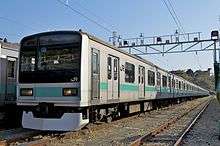 A Joban Line 209–1000 series EMU, November 2011
A Joban Line 209–1000 series EMU, November 2011- A Joban Line E233-2000 series EMU, June 2012
 A Tokyo Metro 6000 series train for Toride
A Tokyo Metro 6000 series train for Toride- A Tokyo Metro 16000 series train
 An Odakyu 4000 series train
An Odakyu 4000 series train
- Odakyu 4000 series
- JR East stock
- Jōban Line (Rapid)
- E231 series 10+5-car EMUs
 A Joban Line E231 series EMU, July 2008
A Joban Line E231 series EMU, July 2008
- E231 series 10+5-car EMUs
- Jōban Line
- E501 series 10+5-car EMUs (Operates only between Tsuchiura and Kusano)
- E531 series 10+5-car EMUs
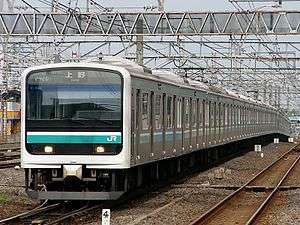 An E501 series EMU, April 2003
An E501 series EMU, April 2003- A Joban Line E531 series EMU stopping at Ueno, October 2014
Iwaki – Sendai
- 701 series
- 719 series
- E531 series
- E721 series
- A JR East 701 series train at Kashima Station, May 2014
 A JR East E531 series train
A JR East E531 series train A JR East E721 series train at Sendai Station, August 2010
A JR East E721 series train at Sendai Station, August 2010
Limited express stock
- E657 series 10-car EMUs (Hitachi/Tokiwa services) (from 17 March 2012)
 An E657 series EMU on a Super Hitachi service, July 2011
An E657 series EMU on a Super Hitachi service, July 2011
Past
- 80 series DMUs (Hitachi services) (from October 1969 until October 1972)
- 401 series EMUs (cream with blue stripe) (from June 1961 until 1987)
- 485 series EMUs (Hitachi services) (from October 1972 until December 1998)
- 103 series 10+5-car EMUs (emerald green livery) (from December 1967 until March 2006)
- 403 series/415 series 7+4+4-car EMUs (cream with blue stripe) (from 1965 until March 2007)
- 207–900 series 10-car EMU (x1) (Tokyo Metro Chiyoda Line through-running services, emerald green stripe) (from 1986 until December 2009)
- 203 series 10-car EMUs (Tokyo Metro Chiyoda Line through-running services, emerald green stripe) (from 1982 until 26 September 2011)[9]
- 415–1500 series 4-car EMUs (blue stripe) (from 1986 until 2016)
- 651 series 7+4-car EMUs (x9) (Hitachi services) (from March 1989 until March 2015)
- E653 series 7+4-car EMUs (Fresh Hitachi services) (from October 1997 until March 2013)
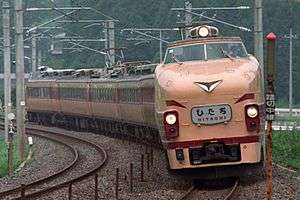 A 485 series EMU on a Hitachi service, August 1998
A 485 series EMU on a Hitachi service, August 1998- A Joban Line 103 series EMU, January 2003
- A Joban Line 415 series EMU, July 2006
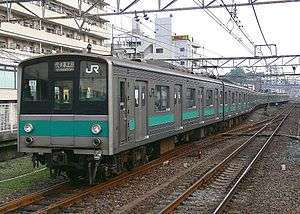 The sole 207-900 series EMU, May 2006
The sole 207-900 series EMU, May 2006- A 203 series EMU, July 2009
- A 415-1500 series EMU in September 2007
 A 651 series EMU on a Super Hitachi service, July 2008
A 651 series EMU on a Super Hitachi service, July 2008 An E653 series EMU on a Fresh Hitachi service, April 2003
An E653 series EMU on a Fresh Hitachi service, April 2003
History
The Mito Railway opened the line in sections between 1889 and 1905. The dates of the individual section openings are given below. After the line was nationalised in 1906, a program of double-tracking commenced in 1910, with the 219 km section between Nippori and Yotsukura completed in 1925. The Hirono - Kido and Ono - Futaba sections were double-tracked in 1976.
The first section electrified was Nippori - Matsudo (at 1,500 V DC) in 1936, and extended to Toride in 1949. The Toride - Kusano section was electrified at 20 kV AC between 1961 and 1963, and extended to Iwanumi in 1967.
The 2011 Tohoku earthquake and tsunami caused severe disruption to the line, with services to Iwaki (209.4 km from Nippori) re-established by 17 April, to Yotsukura (a further 9.8 km) by 14 May, and to Hirono (another 13.2 km) by 10 October 2011. Services on the 8.5 km Hirono - Tatsuta section returned on 1 June 2014.
At the northern end, services on the isolated 20.1 km Haranomachi - Soma section were restored on 21 December 2011, with services from Iwanuma to Hamayoshida (13.5 km) restored on 16 March 2013. Services resumed on the 9.4 km Haranomachi - Odaka section on 12 July 2016 and the 22.6 km Hamayoshida - Soma section was rebuilt at a higher, tsunami-proof level, and reopened on 10 December 2016, re-establishing the connection to Sendai for stations north of Odaka. The 33.6 km Odaka - Tatsuta section is proposed to reopen in stages by March 2020.[1]
Timelines
- January 16, 1889: Mito Railway (Mito — Oyama) begins operation.
- November 26, 1890: Mito Railway Freight Line (Mito — Nakagawa) begins operation.
- March 1, 1892: Mito Railway becomes part of the Nippon Railway.
- November 4, 1895: Nippon Railway Tsuchiura Line (Tsuchiura — Tomobe) begins operation.
- December 1, 1895: Hatori Station opens.
- December 25, 1896: Tsuchiura Line (Tabata — Tsuchiura), Sumidagawa Line (Tabata — Sumidagawa) begin operation.
- February 25, 1897: Iwaki Line (Mito — Taira [present-day Iwaki]) begins operation.
- May 17, 1897: Tsuchiura Line Kameari Station opens.
- August 29, 1897: Iwaki Line (Taira — Kunohama) begins operation.
- November 10, 1897: Iwaki Line (Nakamura [present-day Sōma] — Iwanuma) begins operation.
- December 27, 1897: Tsuchiura Line Kanamachi Station opens.
- January 1898: Kitasenju — Sumidagawa connection opens.
- April 1, 1898: Ishigami Station opens.
- April 3, 1898: Iwaki Line (Haranomachi — Nakamura) begins operation.
- May 11, 1898: Iwaki Line (Odaka — Haranomachi) begins operation.
- August 6, 1898: Tsuchiura Line Mabashi Station opens.
- August 23, 1898: Iwaki Line (Kunohama — Odaka) begins operation, connecting Tabata and Iwanuma. Tsuchiura Line and Mito Line (Tomobe — Mito) and Iwaki Line are collectively renamed the Kaigan Line.
- December 1, 1898: Taka Station is renamed Iwaki-Ōta Station.
- August 4, 1900: Sanuki Station opens.
- November 22, 1904: Ōno Station opens.
- April 1, 1905: With the completion of Mikawashima — Nippori connection, the present-day route is finished. Nippori and Mikawashima Stations open. Service from Ueno to Tabata and back is abolished.
- November 1, 1906: Nippon Railway is nationalized.
- March 25, 1909: Tatsuta Station opens.
- October 12, 1909: Kaigan Line split and renamed: Jōban Line (Nippori — Iwanuma) and Sumidagawa Line (Tabata — Sumidagawa). Jōban Line also handles freight services.
- February 16, 1910: Minami-Nakagō Station opens.
- March 18, 1910: Katsuta and Ogitsu Stations open.
- May 1, 1911: Kita-Kogane Station opens.
- May 5, 1911: Sumidagawa Line is merged into the Jōban Line.
- June 1, 1915: Yoshida Station is renamed Hamayoshida Station.
- March 15, 1921: Yonomori Station opens.
- August 15, 1922: Nittaki Station opens.
- February 2, 1925: Kōen-Shimo Station opens, but only operates during the ume blossom-viewing season.
- October 28, 1925: Nippori — Taira connection finished (joined with northern tracks in 1965).
- December 11, 1936: Nippori — Matsudo tracks are electrified.
- October 1, 1939: Shimomago Station is renamed Hitachi-Taga Station.
- October 20, 1939: Sukegawa Station is renamed Hitachi Station.
- February 15, 1944: Momouchi signal box is built between Namie and Odaka.
- February 20, 1944: Suetsugi signal box is built between Kunohama and Hirono.
- June 1, 1947: Suetsugi signal box becomes Suetsugi Station.
- August 10, 1948: Momouchi signal box becomes Momouchi Station.
- May 10, 1949: Shimoyama Station opens.
- June 1, 1949: Matsudo — Toride tracks are electrified.
- July 6, 1949: In what is known as the Shimoyama incident, JNR president at the time, Shimoyama Sadanori, is mysteriously found dead between Kita-Senju and Ayase Stations.
- May 10, 1950: Sekimoto Station is renamed Ōtsukō Station.
- May 1, 1952: Kita-Matsudo Station opens.
- July 10, 1952: Komagamine Station opens.
- October 1, 1953: Minami-Kashiwa Station opens.
- December 20, 1956: Tsuzura Station is renamed Uchigō Station.
- April 1, 1957: Ishigami Station is renamed Tōkai Station.
- June 1, 1958: Semi-express Tokiwa begins operation.
- October 10, 1958: The Limited express Hatsukari begins operation (Ueno — Aomori). It stops at Ueno, Mito, Taira, and Sendai Stations when it runs on the Jōban Line tracks.
- October 1, 1959: Nagatsuka Station is renamed Futaba Station.
- October 1, 1960: Kanayama signal box is built between Tatsuta and Tomioka. Ōkuma signal box is built between Watari and Iwanuma.
- March 20, 1961: Nakamura Station is renamed Sōma Station.
- June 1, 1961: Toride — Katsuta tracks are electrified.
- May 3, 1962: The Mikawashima Rail Crash occurs between Mikawashima and Minami-Senju when an Iwaki-bound passenger train crashes into the wreckage of a crash between an Ueno-bound passenger train and an Ueno-bound freight train. 160 people die and 296 are injured in the incident.
- October 1, 1962: Katsuta — Takahagi tracks are electrified.
- May 1, 1963: Takahagi — Taira tracks are electrified.
- April 20, 1963: Takahira signal box is built between Haranomachi and Kashima.
- September 30, 1963: Taira — Kusano tracks are electrified.
- March 5, 1966: Tokiwa semi-express becomes an express.
- February 1, 1967: Kōen-Shimo Station is renamed Kairakuen Station.
- August 20, 1967: With the electrification of the Kusano — Iwanuma tracks, the entire Jōban Line becomes electrified.
- October 1, 1968: Hatsukari express is rerouted to the Tōhoku Main Line.
- October 1, 1969: Kairakuen Station becomes a temporary station. Seasonal Hitachi express begins operation.
- April 10, 1970: Freight line Kita-Kashiwa Station opens.
- October 1, 1970: Hitachi operates as a regular express.
- April 20, 1971: Construction of the Kita-Senju — Abiko Joban Local Line is finished and runs through service to the Eidan Subway Chiyoda Line (present-day Tokyo Metro Chiyoda Line). (The Chiyoda Line only ran as far as Kasumigaseki at the time). Tennōdai Station opens and Kita-Kashiwa Station is open to passengers.
- April 1, 1973: Shin-Matsudo Station opens.
- March 31, 1978: With the extension of its tracks to Yoyogi-Uehara Station, the Chiyoda Line shares tracks with the Odakyu Odawara Line up to Hon-Atsugi Station. 203 series trains are introduced to run through service to the Chiyoda Line.
- November 15, 1982: Jōban Local Line extended from Abiko — Toride.
- February 1, 1984: Mito — Nakagawa freight line is closed.
- March 14, 1985: Bampaku-Chūō Station is temporarily opened (until September 16) for the Tsukuba Expo '85. The Uchigō-System-ku is abolished. The Tokiwa express is discontinued.
- April 1, 1987: With the split of JNR, the Joban Line becomes part of JR East.
- August 2, 1988: Ōkuma signal box becomes Ōkuma Station.
- March 11, 1989: 651 series Super Hitachi limited-express EMUs enter service.
- February 1, 1993: Kanayama signal box is abolished.
- February 10, 1993: Takahira signal box is abolished.
- December 3, 1994: Taira Station is renamed Iwaki Station.
- December 1, 1995: E501 series begins service between Ueno and Tsuchiura.
- October 1, 1997: E653 series Fresh Hitachi limited-express EMUs enter service.
- March 14, 1998: Hitachino-Ushiku Station opens where Bampaku-Chūō Station used to stand.
- December 7, 1998: 485 series Hitachi limited-express EMUs are retired.
- March 3, 2002: New E231 series EMUs introduced on commuter services.
- March 13, 2004: Kawajiri Station is renamed Jūō Station. Regular trains begin making stops at Mikawashima and Minami-Senju Stations throughout the day.
- October 16, 2004: Medium-distance trains are called rapid trains for the section between Ueno and Toride.
- July 9, 2005: New E531 series dual-voltage EMUs enter service on line. Special Rapid Service begins between Ueno — Tsuchiura. Commuter Rapid service from Ueno ends. One Commuter Rapid service still runs from Mito to Ueno.
- March 17, 2006: All Commuter Rapid Service ends.
- May 15, 2006: Women-only cars introduced on Joban Local Line trains [7:10 – 9:30 AM measured by the time the trains pass through Ayase station] from Toride running through to Yoyogi-Uehara on the Tokyo Metro Chiyoda Line.
- January 6, 2007: Double-deck Green cars are phased in on E531 series EMUs running between Ueno and Takahagi. No Green car supplement required until start of new timetable on 2007-03-18.
- February 21, 2007: E501 series EMUs removed from Ueno – Tsuchiura services.
- March 18, 2007: Full Green car service commences on E531 series EMUs running between Ueno and Takahagi; E501 series EMUs reassigned to Mito Line and Jōban services north of Tsuchiura become 10-car or 5-car formations only
- March 15, 2008: Suica use extended to stations between Hitachi and Takahagi
- March 14, 2009: Suica use extended to Takahagi – Iwaki and Haranomachi – Yamashita sections
- September 9, 2009: E233 series 10-car EMUs introduced on Chiyoda Line through services
- March 11, 2011: During the 2011 Tōhoku earthquake and tsunami, a 4-car train on the line was picked up off the tracks by the tsunami surge and overturned at Shinchi and Tomioka stations. All passengers from the train were evacuated before the tsunami came ashore. Tomioka was affected by the Fukushima nuclear disaster and was prohibited entrance without legal permission.
- January 8, 2014: Thales is selected to design Japan's first communications-based train control system (CBTC) on the line.[10]
- May 2014: Test-running commenced on the section of the line between Hirono and Tatsuta stations closed since the March 2011 earthquake and tsunami, with the intention of resuming passenger services on this section from 1 June.[11]
- June 1, 2014: Train operations resumed between Hirono and Tatsuta.[12]
- July 12, 2016: Train operations were resumed between Odaka and Haranomachi stations in Minami-Soma, Fukushima Prefecture.[13]
- December 10, 2016: The 23 km reconstructed section between Soma and Hamayoshida reopened.[1]
- April 1, 2017: Train services from Odaka south to Namie resumed.[7]
- October 21, 2017: Train services resumed north from Tatsuta to Tomioka.[14]
Former connecting lines
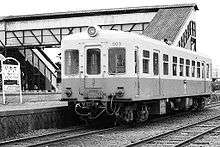
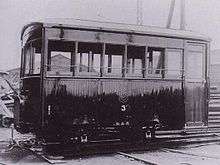
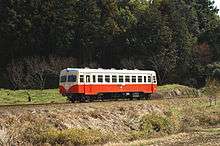
- Tsuchiura Station: The Tsukura Railway opened a 40 km line to Iwase on the Mito Line in 1918. Freight services ceased in 1981, and the line closed in 1987.
- Tsuchiura Station: A 5 km line to Ami, electrified at 600 VDC, was operated by the Southern Electric Railway Co. between 1926/28 and 1938.
- Mito Station: The Mito Seashore Electric Railway Co. opened a line eventually extending 21 km between Kamimito and Nakaminato-Cho, electrified at 600 VDC, between 1922 and 1930. It closed in sections between 1953 and 1966. At Onuki station (12 km from Mito) on this line the Kashima Light Railway Co. operated a 17 km 762mm gauge line between 1926 and 1930 to Hokota (see Ishioka station entry below).
- Mito Station: The Mito Electric Railway Co. operated an 11 km line to Okunotani (not electrified, despite the company name) between 1929 and 1936.
- Ishioka Station: The Kashima Sangu Railway opened a 27 km line to Hokota between 1924 and 1929. Freight services ceased in 2002 and the line closed in 2007.
- Akatsuka Station: A 25 km line to Gozenyama was opened by the Ibaraki Railway Co. in 1926/27. In 1944/45 the first 4 km of the line to Minami Hakamatsuka was electrified. The line closed in sections between 1965 and 1971.
- Tokai Station: The Ibaraki Prefectural Government operated a 4 km 762 mm (2'6") gauge line to Muramutsu between 1926 and 1933.
- Omika Station: An 11 km line to Johoku Ota (now Hitachi-Ota on the Suigun Line) was opened by the Johoku Electric Railway in 1928/29. In 1944 the company merged with the Hitachi Electric Railway, and a 7 km line to Akukawa was opened in 1947. Both lines were electrified at 600 V DC from opening. CTC signalling was commissioned in 1969, and in 1971 the lines became the first electric railway in Japan converted to one-person operation. Both lines closed in 2005.
- Izumi Station: The Onahama Horse tram opened a 762 mm gauge line 5 km to its namesake town in 1907, and extended the line a further 5 km to Ena in 1916. The Onahama - Ena section closed in 1936, the company renamed itself the Onahama Port Railway in 1939, and converted the line to 1,067 mm gauge in 1941. The Ena Railway rebuilt the Onahama - Ena section as 1,067 mm gauge in 1953. In 1965 a typhoon caused the collapse of a retaining wall, and the Onahama - Ena section formally closed in 1967. The passenger service on the Izumi - Onahama section ceased in 1972, the line is now freight-only operated by the Fukushima Rinkai Railway.
- Yumoto station: The 10 km 762mm gauge Iwaki Coalmine Railway operated to Onahama between 1905 and 1944.
- Yumoto station: A 6 km 762mm gauge line to Nagahashi was operated by the Iwaki City Council between 1914 and 1929.
- Uchigo station: The Furukawa Co. built a 7 km 762mm gauge line to the Kita-Yoshima coal mine in 1905. In 1908 the line was rebuilt to 1067mm gauge and shortened by 1 km. The mine and line closed in 1969.
- Iwaki station: The Yoshima and Akai local railways connected here, details of these lines are not currently available.
References
This article incorporates material from the corresponding article in the Japanese Wikipedia.
- 1 2 3 4 "Tsunami-hit railway line partially reopens - News - NHK WORLD - English". .nhk.or.jp. Retrieved 2016-12-10.
- ↑ 河尻, 定 (24 April 2015). "座れぬ・行き先?… 乗客の声で検証、上野東京ライン". Nihon Keizai Shimbun. Retrieved 24 April 2015.
- ↑ JR East press release: "Archived copy" (PDF). Archived from the original (PDF) on 2012-01-30. Retrieved 2016-03-14.
- ↑ Hongo, Jun, "A year on, Tohoku stuck in limbo", The Japan Times, 11 March 2012, p. 1.
- ↑ "水戸駅・常磐線|JR東日本旅客鉄道株式会社 水戸支社|東日本大震災による列車影響と運転見込みについて". Jrmito.com. Retrieved 2016-12-10.
- ↑ http://www.jreast.co.jp/pdf/damage03.pdf
- 1 2 "Photo Journal: All aboard". 1 April 2017. Retrieved 21 March 2018 – via Mainichi Daily News.
- ↑ 7-km part of Joban Line reopens in Fukushima. 21 October 2017. Retrieved 21 October 2017.
- ↑ 203系が営業運転から離脱 [203 series withdrawn from revenue service]. Japan Railfan Magazine Online (in Japanese). Japan: Koyusha Co., Ltd. 28 September 2011. Retrieved 28 September 2011.
- ↑ Briginshaw, David (January 8, 2014). "JR East selects Thales to design first Japanese CBTC". hollandco.com. Holland. Retrieved January 9, 2014.
- ↑ JR常磐線、広野―竜田で試運転を開始 [Test-running starts on JR Joban Line between Hirono and Tatsuta]. Asahi Shimbun Digital (in Japanese). Japan: The Asahi Shimbun Company. 2014-05-11. Retrieved 2014-05-12.
- ↑ "Train services resume in evacuation zone". The Japan news. Japan: The Yomiuri Shimbun Company. 2014-06-01. Archived from the original on 2014-06-06. Retrieved 2014-06-07.
- ↑ "Evacuation order lifted in Minami-Soma after 5 years". The Asahi Shimbun. Japan: The Asahi Shimbun. 2016-07-12. Retrieved 2016-07-12.
- ↑ https://mainichi.jp/english/articles/20171021/p2g/00m/0dm/065000c
External links
| Wikimedia Commons has media related to Jōban Line. |
- Stations of the Jōban Line (JR East) (in Japanese)
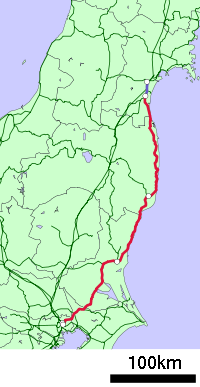
.svg.png)